Anna Lena Keller (*1993 in Weilheim i.Ob.) is a visual artist who lives and works in Munich in the media of sculpture and installation. She studied at the Academy of Fine Arts in Munich with Prof. Hermann Pitz and Prof. Nicole Wermers and graduated with the diploma in 2023 with Nicole Wermers. In 2024 she received the Debütant*innen Förderung of the BBK München und Oberbayern and her solo show"konturfedern“ will take place in the Kunstpavillon im alten botanischen Garten in April 2025. In her artistic practice, she deals with body-expanding structures as well as non-human protective mechanisms, exploring the tension between "natural" and "processed" materials.
(TITLE) Armierung (YEAR) 2020 (DIMENSIONS) 88 x 50 x 19 cm (MATERIALS) Steel, metal chains
In the course of evolution, certain animals and plant species have developed armor, thick skins and mucous secretions to protect themselves from the outside world and from natural enemies and environmental influences. This proactive defense is an integral part of their body and their DNA.
An analogy to this is armor, helmets and body part protectors, which prevent injuries and were often inspired by animal solutions to problems. However, unlike with non-human creatures, our wearing or use of these objects is always preceded by an active decision.
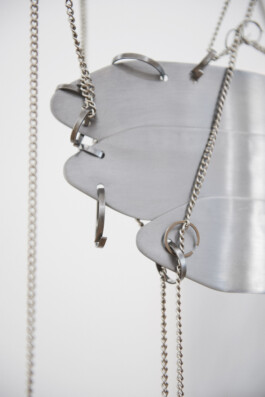
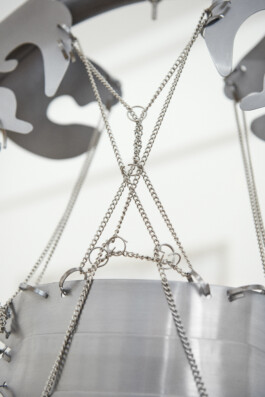
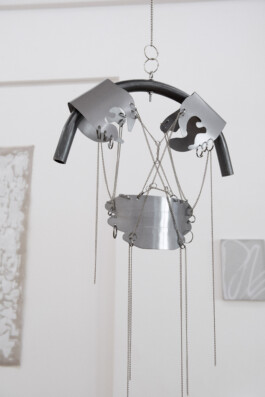
(TITLE) bugs (YEAR) 2023 (DIMENSIONS) each 29,5 x 21,5 x 10,5 cm (MATERIALS) Stainless steel welded and oxidized
The metal objects protruding into the space are the result of a fascination with so-called “animal robots”. These are used, among other things, for espionage or research purposes in nature. The English word “bug” refers not only to an insect but also to the function of eavesdropping through a technical device, as well as a programming error in information technology (IT).
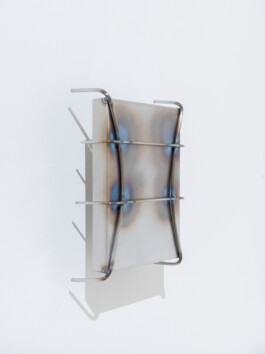
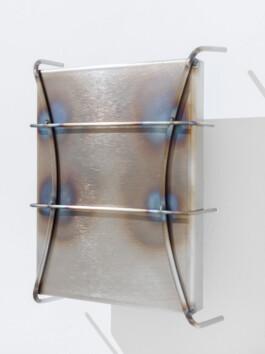
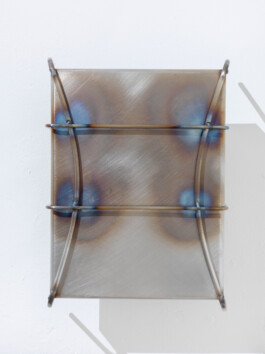
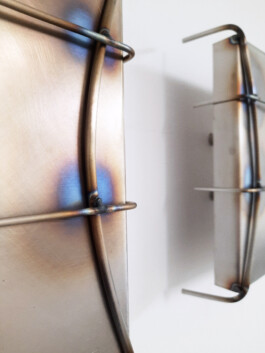
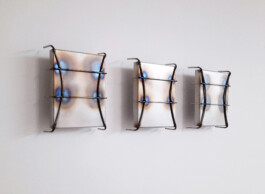
(TITLE) cast_1 (YEAR) 2025 (DIMENSIONS) 100 x 39 x 15 cm (MATERIALS) Thermoplastic material - Mixed granules of wood and plastic
“Cast” evokes associations of support structures and insect shells; it seems as if ergonomic exoskeletons are contrasting beneath the light, textured surface. These objects extend the physical properties of the human body in terms of measurable effciency and performance.
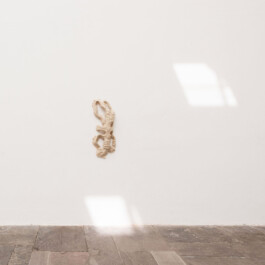
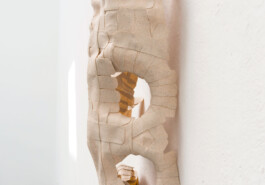
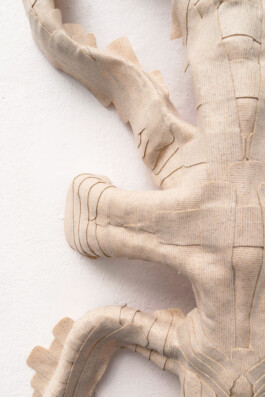
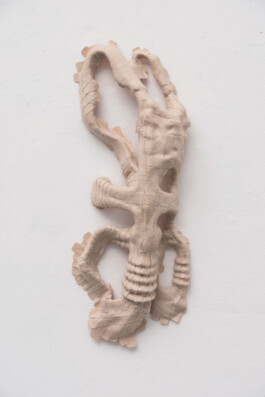
(TITLE) cast_2 (YEAR) 2025 (DIMENSIONS) 54 x 31 x 11 cm (MATERIALS) Thermoplastic material - Mixed granules of wood and plastic
“Cast” evokes associations of support structures and insect shells; it seems as if ergonomic exoskeletons are contrasting beneath the light, textured surface. These objects extend the physical properties of the human body in terms of measurable effciency and performance.
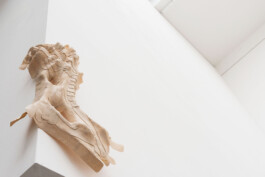
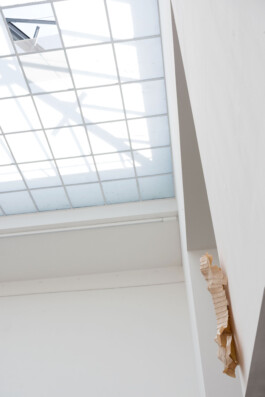
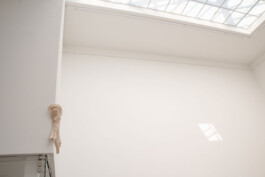
(TITLE) Debütant*innen (YEAR) 2024
Installation views from the exhibition "Debütant*innen 2024," sponsored and organized by the BBK München und Oberbayern at‚ the Galerie der Künstler*innen in Munich.
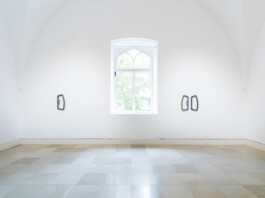
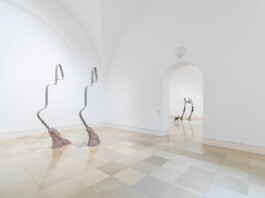
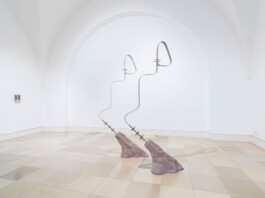
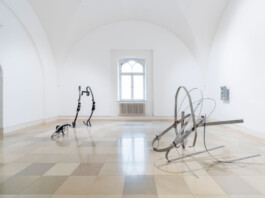
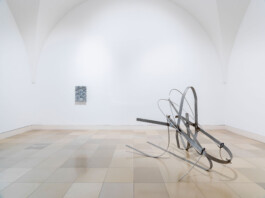
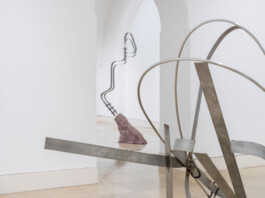
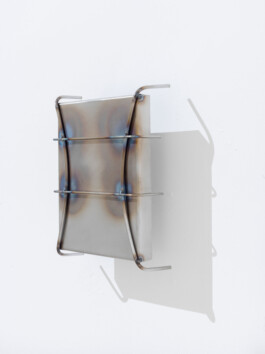
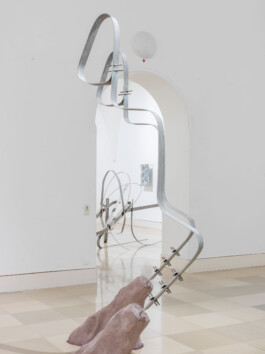
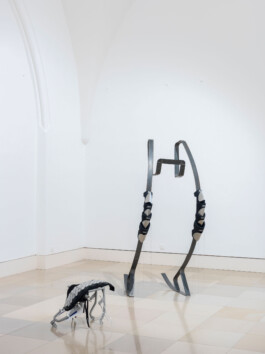
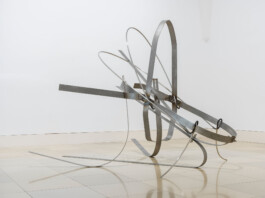
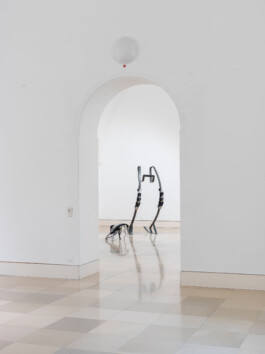
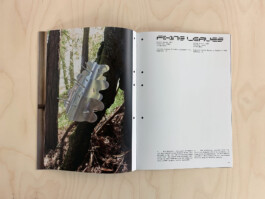
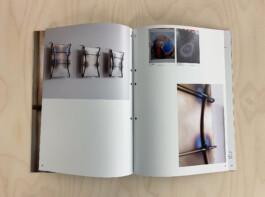
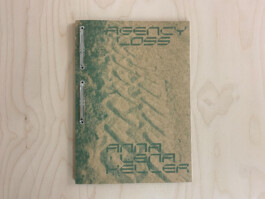
(TITLE) fixing leaves (YEAR) 2023 (DIMENSIONS) 41 x 35 x 30 cm (MATERIALS) Aluminum, steel
Djerassi Artists Residency Sculpture-Park,
Woodside, US
The sculpture, screwed with the burnt-out Redwood trunk by drilling, is inspired by osteosynthesis. In this medical procedure, bone fractures are reattached with the help of metallic objects.

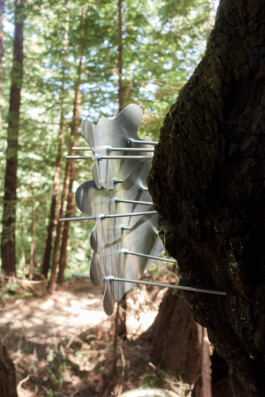
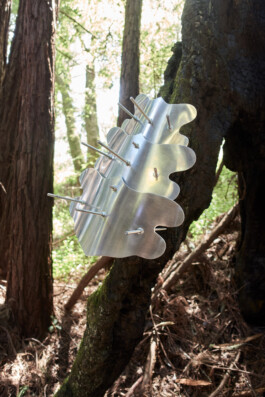
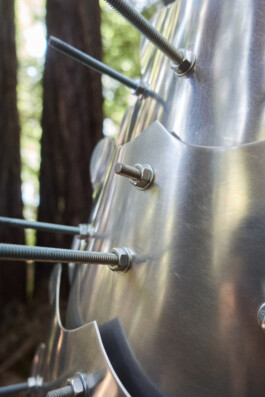
(TITLE) konturfedern (YEAR) 2025
Exhibition views from the solo show "konturfedern" 2025 at the Kunstpavillon in Munich.
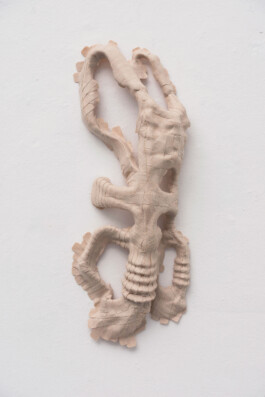
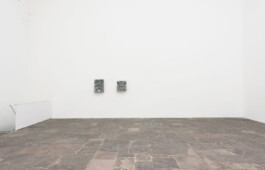
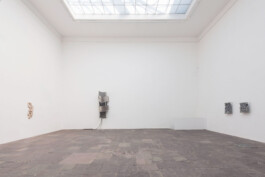
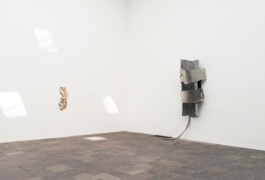
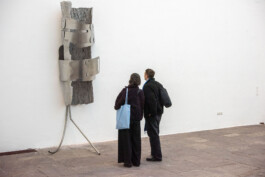
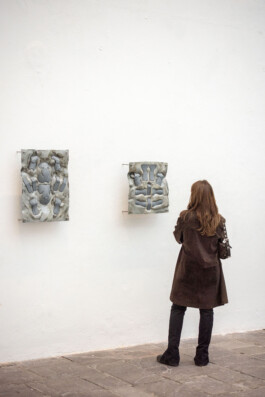
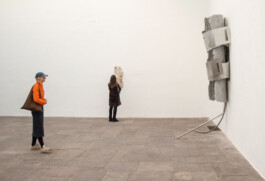
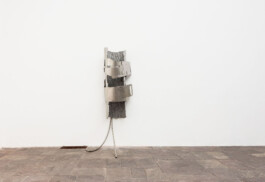
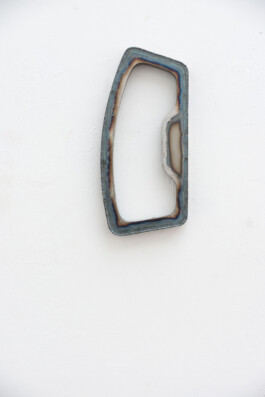
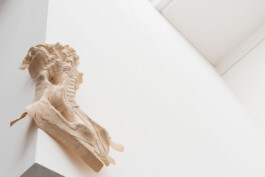
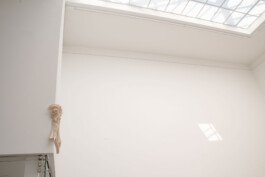
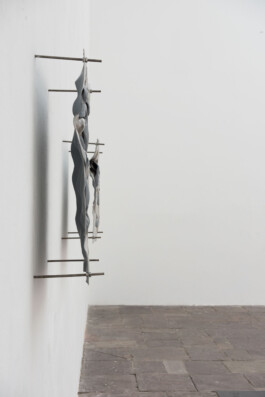
(TITLE) Kufen (YEAR) 2024 (DIMENSIONS) 60 x 29 x 5 cm
The wall-mounted steel work recalls the shape of a baby cradle’s runners – the first vehicle of a human being, marking the transition from the mother’s physical closeness to an external shaping and initiation of movement. The surface of the steel bears visible traces of its processing: welding seams, irregularities, and grinding marks. Through the controlled application of heat, iridescent temper colors have emerged on the material, evoking organic processes and emphasizing the vitality of steel as a natural raw material.
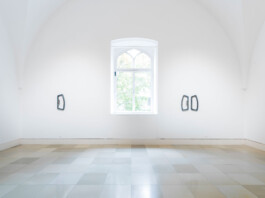
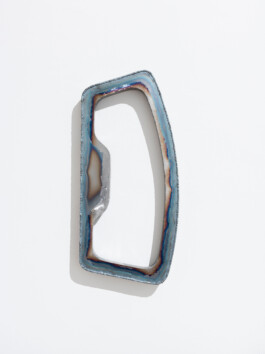
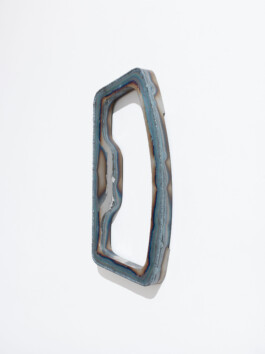
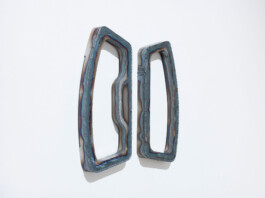
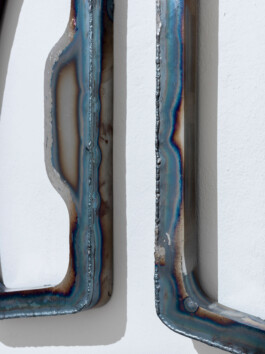
(TITLE) Läufer (YEAR) 2021 (DIMENSIONS) 193 x 80 x 85 cm (MATERIALS) Flat steel, stainless steel, knee pads
Parts of the “exoskeleton” in motion are protected by modified ready-made knee protectors from recreational and professional sports. Staggered and equipped with steel caps, they make reference to the exoskeletons of insects and robotic joints.
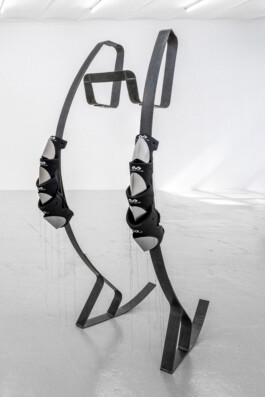
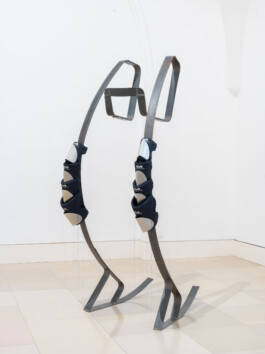
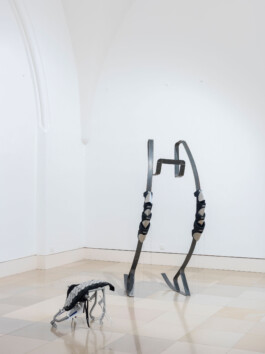
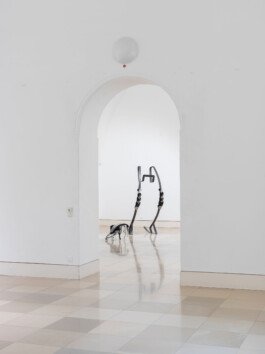
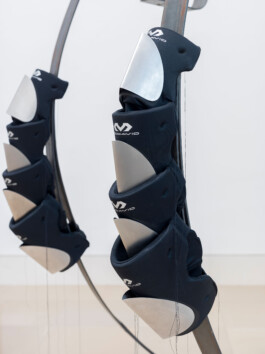
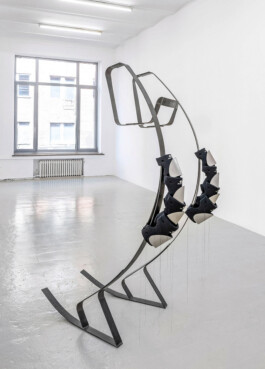
(TITLE) Limitation Game (YEAR) 2023
Exhibition views from the diploma show "konturfedern" in 2023 at the Akademie der bildenden Künste München.
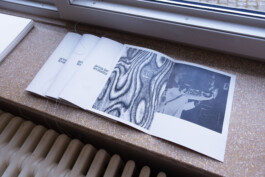
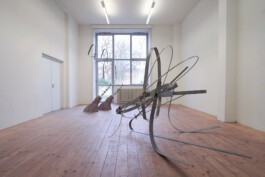
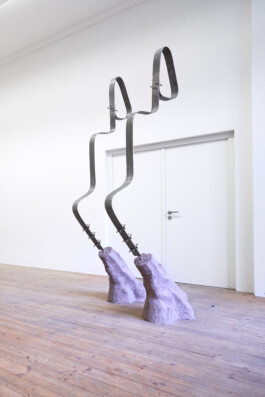
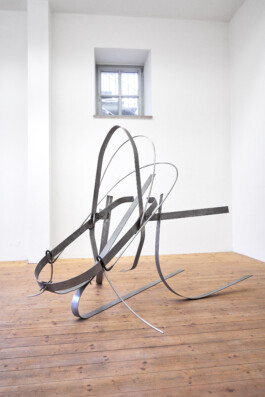
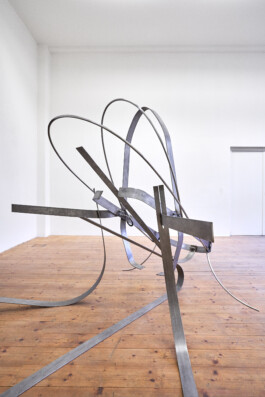
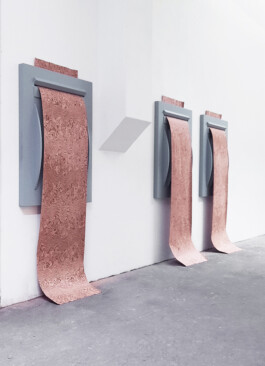
(TITLE) Limitation game 1 (YEAR) 2023 (DIMENSIONS) 234 x 172 x 183 cm (MATERIALS) Stainless steel bent and screwed
Inspired by so-called “lift assist recliners” the sculpture Limitation game 1 is frozen in a neither horizontal nor vertical intermediate phase. Design elements from the everyday lives of seniors, oriented towards passivity and activity, are inter- twined with pop-cultural motifs.
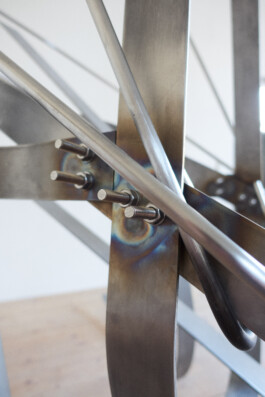
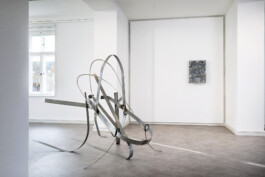
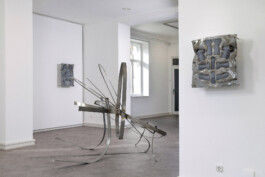
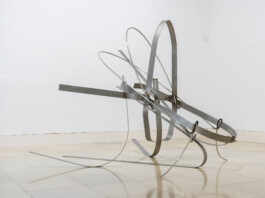
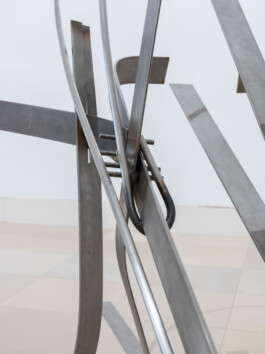
(TITLE) Limitation game 2 (YEAR) 2023 (DIMENSIONS) 249 x 86 x 108 cm (MATERIALS) Stainless steel, concrete, pigment
Biotechnological modifications also have a tendency to delegate self-improvement to external agencies. Because the extension of the body towards a technical apparatus always also means:”... handing over agency to a non-human operator.” Karin Harrasser „Körper 2.0” (transcript Verlag, 2013) Translation: Anna Lena Keller
The soaring sculpture Limitation game 2 refers to this interweaving of the muscular and the modular.
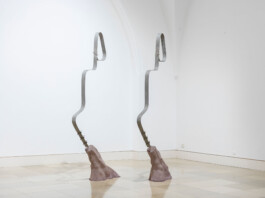
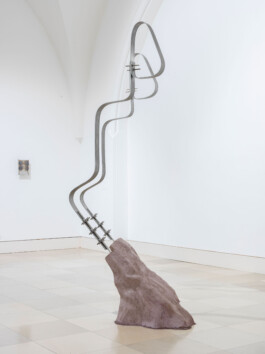
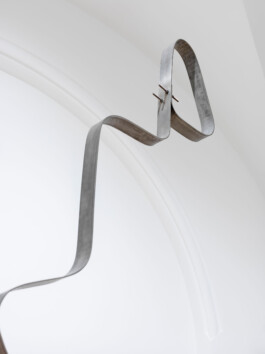
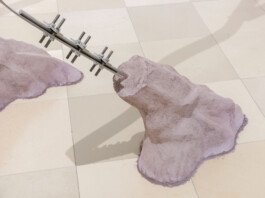
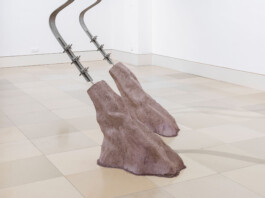
(TITLE) Limitation game 3 (YEAR) 2023 (DIMENSIONS) 206 x 100 x 14 cm (MATERIALS) Mdf, plastic lacquer, poplar veneer
Based on a different protective behaviour of animals, the mimese, the wall objects show inlaid images made of SaRaiFo Buminga sliced veneer. As is well known, veneer imitates more expensive solid wood as a glued surface of, for example, cheap chipboard. In the case of SaRaiFo veneers, endangered tropical precious wood species are imitated in a kind of double imitation by coloured and multiple glued poplar wood.
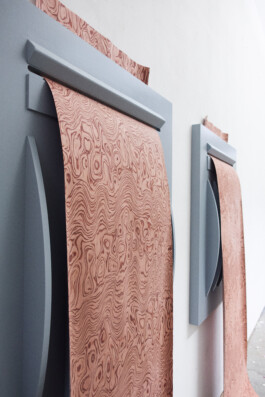
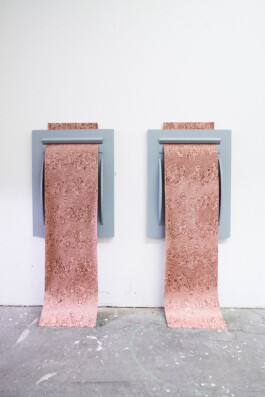
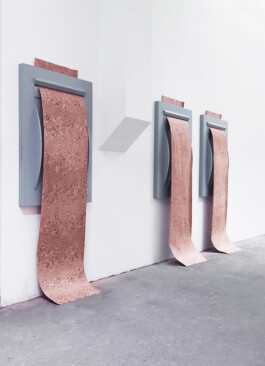
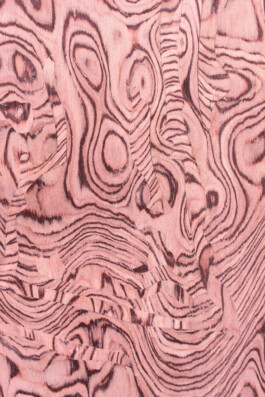
(TITLE) soft crust (YEAR) 2023 (DIMENSIONS) 67 x 48 x 26 cm, 54 x 49 x 26 cm (MATERIALS) Parts of body part protectors, leather, PVC, stainless steel
The wall works feature found joint protectors covered in leather and fitted into negative molds - based on the molding processes used in archaeology.
The organic, raw materiality is pressed under the shiny surface of the containers. As a whole, the objects appear like parts of an artificial landscape.
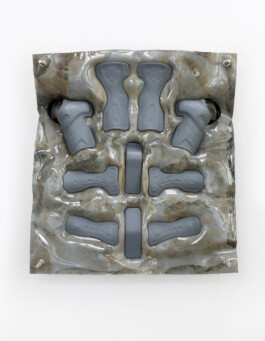
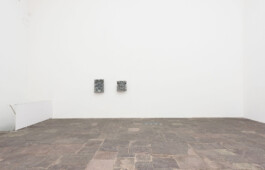
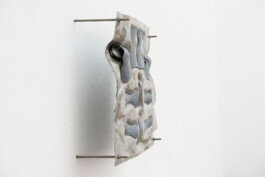
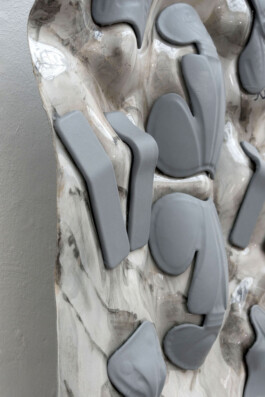
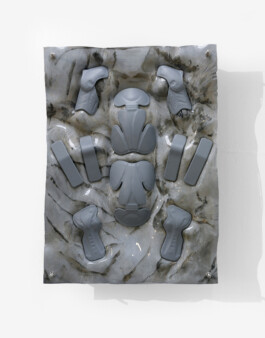
(TITLE) supersafety (YEAR) 2024 (DIMENSIONS) 55 x 56 x 42 cm (MATERIALS) Steel, Stainless steel, Aluminum, found protectors for professional sports
The hybrid body form, equipped with modular elements, features a surface that resembles the microscopic structure of shark skin. This visual language references bionic research, in which the specific texture of this animal skin was analyzed and technically adapted. Based on these findings, a performance-enhancing swimsuit was developed for professional swimming—an innovation that was later banned due to the unfair advantage it provided.
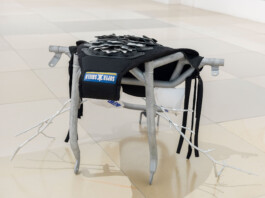
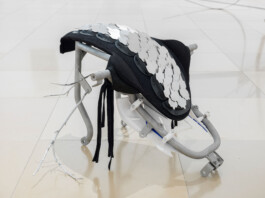
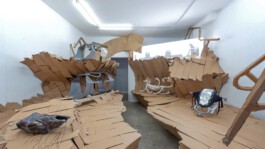
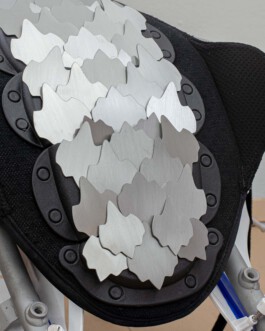
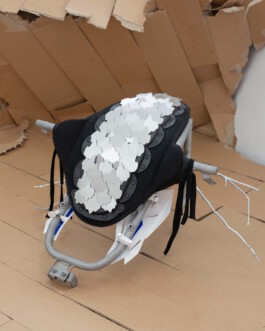
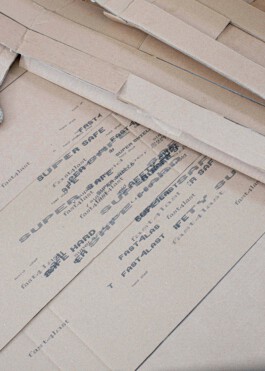
(TITLE) swoosh (YEAR) 2025 (DIMENSIONS) 210 x 210 x 80 cm (MATERIALS) Stainless steel, steel, partly oiled, partly rusted
The work swoosh picks up the tradition of wishing wells, but shifts them out of the controlled architectural framework back into a natural environment. The temporary installation is located in theGollach (river near Würzburg) - a place where the water is already flowing anyway. The work reflects the strange combination of immaterial desires, spiritual beliefs and the very earthly act of tossing a coin.
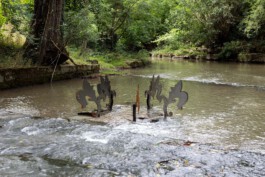
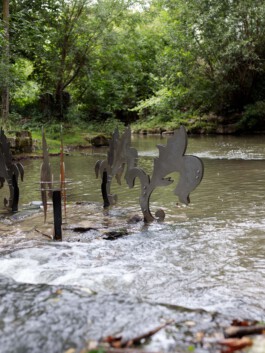
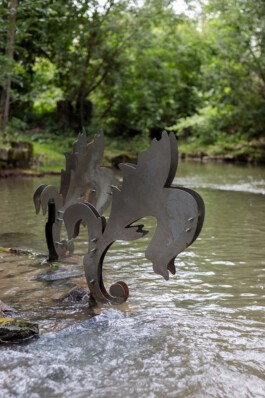
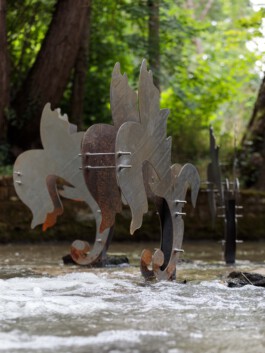
(TITLE) tek-ees (YEAR) 2022 (DIMENSIONS) 180 x 220 x 68 cm (MATERIALS) Steel, leather, electrical cable, thread
The three-part work developed through a confrontation with the physical objects of protection of humans and non-human beings. The hybrid creatures wear steel- made, hard armor on their saddle-shaped leather ribs.
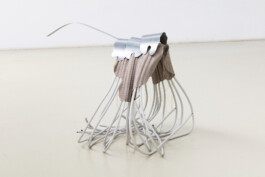
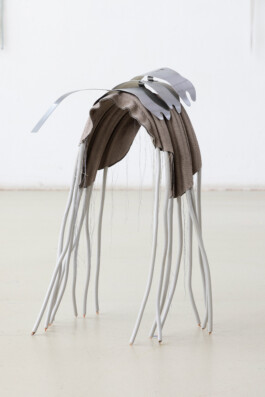
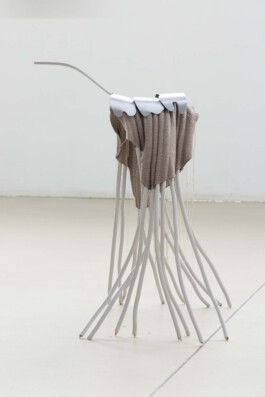
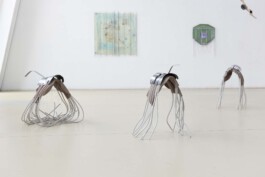
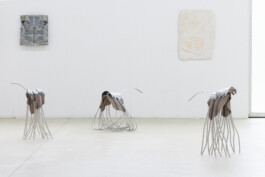
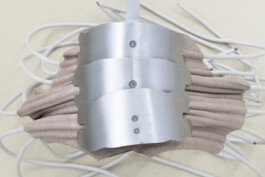
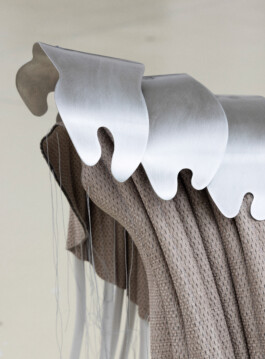
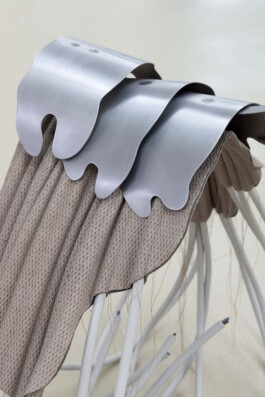
(TITLE) Tension Tissue (YEAR) 2025 (DIMENSIONS) 330 x 140 x 110 cm (MATERIALS) Cellulose dyed with beech charcoal, Stainless steel
The large-scale piece „Tension Tissue“, protruding into the space, feature rough textures and intricate surfaces made of paper. It is a negative impression of a poplar tree, an imprint of the outermost protective layer. Deep furrows and grooves run across the inner side of the inverted, semi-circular surface, which is clamped and supported by metal frameworks. Leaning against the wall, the sculptures develop a physical presence that oscillates between organic vitality and technical form.
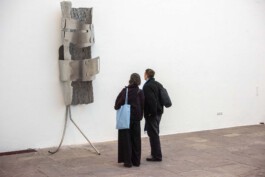
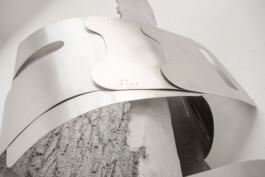
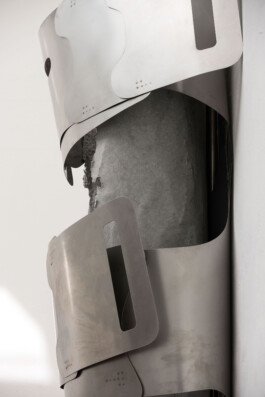
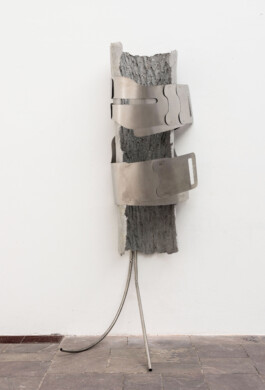
Anna Lena Keller (*1993 in Weilheim i.Ob.) is a visual artist who lives and works in Munich in the media of sculpture and installation. She studied at the Academy of Fine Arts in Munich with Prof. Hermann Pitz and Prof. Nicole Wermers and graduated with the diploma in 2023 with Nicole Wermers. In 2024 she received the Debütant*innen Förderung of the BBK München und Oberbayern and her solo show"konturfedern“ will take place in the Kunstpavillon im alten botanischen Garten in April 2025. In her artistic practice, she deals with body-expanding structures as well as non-human protective mechanisms, exploring the tension between "natural" and "processed" materials.
(TITLE) Armierung (YEAR) 2020 (DIMENSIONS) 88 x 50 x 19 cm (MATERIALS) Steel, metal chains
In the course of evolution, certain animals and plant species have developed armor, thick skins and mucous secretions to protect themselves from the outside world and from natural enemies and environmental influences. This proactive defense is an integral part of their body and their DNA.
An analogy to this is armor, helmets and body part protectors, which prevent injuries and were often inspired by animal solutions to problems. However, unlike with non-human creatures, our wearing or use of these objects is always preceded by an active decision.



(TITLE) bugs (YEAR) 2023 (DIMENSIONS) each 29,5 x 21,5 x 10,5 cm (MATERIALS) Stainless steel welded and oxidized
The metal objects protruding into the space are the result of a fascination with so-called “animal robots”. These are used, among other things, for espionage or research purposes in nature. The English word “bug” refers not only to an insect but also to the function of eavesdropping through a technical device, as well as a programming error in information technology (IT).





(TITLE) cast_1 (YEAR) 2025 (DIMENSIONS) 100 x 39 x 15 cm (MATERIALS) Thermoplastic material - Mixed granules of wood and plastic
“Cast” evokes associations of support structures and insect shells; it seems as if ergonomic exoskeletons are contrasting beneath the light, textured surface. These objects extend the physical properties of the human body in terms of measurable effciency and performance.




(TITLE) cast_2 (YEAR) 2025 (DIMENSIONS) 54 x 31 x 11 cm (MATERIALS) Thermoplastic material - Mixed granules of wood and plastic
“Cast” evokes associations of support structures and insect shells; it seems as if ergonomic exoskeletons are contrasting beneath the light, textured surface. These objects extend the physical properties of the human body in terms of measurable effciency and performance.



(TITLE) Debütant*innen (YEAR) 2024
Installation views from the exhibition "Debütant*innen 2024," sponsored and organized by the BBK München und Oberbayern at‚ the Galerie der Künstler*innen in Munich.














(TITLE) fixing leaves (YEAR) 2023 (DIMENSIONS) 41 x 35 x 30 cm (MATERIALS) Aluminum, steel
Djerassi Artists Residency Sculpture-Park,
Woodside, US
The sculpture, screwed with the burnt-out Redwood trunk by drilling, is inspired by osteosynthesis. In this medical procedure, bone fractures are reattached with the help of metallic objects.




(TITLE) konturfedern (YEAR) 2025
Exhibition views from the solo show "konturfedern" 2025 at the Kunstpavillon in Munich.












(TITLE) Kufen (YEAR) 2024 (DIMENSIONS) 60 x 29 x 5 cm
The wall-mounted steel work recalls the shape of a baby cradle’s runners – the first vehicle of a human being, marking the transition from the mother’s physical closeness to an external shaping and initiation of movement. The surface of the steel bears visible traces of its processing: welding seams, irregularities, and grinding marks. Through the controlled application of heat, iridescent temper colors have emerged on the material, evoking organic processes and emphasizing the vitality of steel as a natural raw material.





(TITLE) Läufer (YEAR) 2021 (DIMENSIONS) 193 x 80 x 85 cm (MATERIALS) Flat steel, stainless steel, knee pads
Parts of the “exoskeleton” in motion are protected by modified ready-made knee protectors from recreational and professional sports. Staggered and equipped with steel caps, they make reference to the exoskeletons of insects and robotic joints.






(TITLE) Limitation Game (YEAR) 2023
Exhibition views from the diploma show "konturfedern" in 2023 at the Akademie der bildenden Künste München.






(TITLE) Limitation game 1 (YEAR) 2023 (DIMENSIONS) 234 x 172 x 183 cm (MATERIALS) Stainless steel bent and screwed
Inspired by so-called “lift assist recliners” the sculpture Limitation game 1 is frozen in a neither horizontal nor vertical intermediate phase. Design elements from the everyday lives of seniors, oriented towards passivity and activity, are inter- twined with pop-cultural motifs.





(TITLE) Limitation game 2 (YEAR) 2023 (DIMENSIONS) 249 x 86 x 108 cm (MATERIALS) Stainless steel, concrete, pigment
Biotechnological modifications also have a tendency to delegate self-improvement to external agencies. Because the extension of the body towards a technical apparatus always also means:”... handing over agency to a non-human operator.” Karin Harrasser „Körper 2.0” (transcript Verlag, 2013) Translation: Anna Lena Keller
The soaring sculpture Limitation game 2 refers to this interweaving of the muscular and the modular.





(TITLE) Limitation game 3 (YEAR) 2023 (DIMENSIONS) 206 x 100 x 14 cm (MATERIALS) Mdf, plastic lacquer, poplar veneer
Based on a different protective behaviour of animals, the mimese, the wall objects show inlaid images made of SaRaiFo Buminga sliced veneer. As is well known, veneer imitates more expensive solid wood as a glued surface of, for example, cheap chipboard. In the case of SaRaiFo veneers, endangered tropical precious wood species are imitated in a kind of double imitation by coloured and multiple glued poplar wood.




(TITLE) soft crust (YEAR) 2023 (DIMENSIONS) 67 x 48 x 26 cm, 54 x 49 x 26 cm (MATERIALS) Parts of body part protectors, leather, PVC, stainless steel
The wall works feature found joint protectors covered in leather and fitted into negative molds - based on the molding processes used in archaeology.
The organic, raw materiality is pressed under the shiny surface of the containers. As a whole, the objects appear like parts of an artificial landscape.





(TITLE) supersafety (YEAR) 2024 (DIMENSIONS) 55 x 56 x 42 cm (MATERIALS) Steel, Stainless steel, Aluminum, found protectors for professional sports
The hybrid body form, equipped with modular elements, features a surface that resembles the microscopic structure of shark skin. This visual language references bionic research, in which the specific texture of this animal skin was analyzed and technically adapted. Based on these findings, a performance-enhancing swimsuit was developed for professional swimming—an innovation that was later banned due to the unfair advantage it provided.






(TITLE) swoosh (YEAR) 2025 (DIMENSIONS) 210 x 210 x 80 cm (MATERIALS) Stainless steel, steel, partly oiled, partly rusted
The work swoosh picks up the tradition of wishing wells, but shifts them out of the controlled architectural framework back into a natural environment. The temporary installation is located in theGollach (river near Würzburg) - a place where the water is already flowing anyway. The work reflects the strange combination of immaterial desires, spiritual beliefs and the very earthly act of tossing a coin.




(TITLE) tek-ees (YEAR) 2022 (DIMENSIONS) 180 x 220 x 68 cm (MATERIALS) Steel, leather, electrical cable, thread
The three-part work developed through a confrontation with the physical objects of protection of humans and non-human beings. The hybrid creatures wear steel- made, hard armor on their saddle-shaped leather ribs.








(TITLE) Tension Tissue (YEAR) 2025 (DIMENSIONS) 330 x 140 x 110 cm (MATERIALS) Cellulose dyed with beech charcoal, Stainless steel
The large-scale piece „Tension Tissue“, protruding into the space, feature rough textures and intricate surfaces made of paper. It is a negative impression of a poplar tree, an imprint of the outermost protective layer. Deep furrows and grooves run across the inner side of the inverted, semi-circular surface, which is clamped and supported by metal frameworks. Leaning against the wall, the sculptures develop a physical presence that oscillates between organic vitality and technical form.



